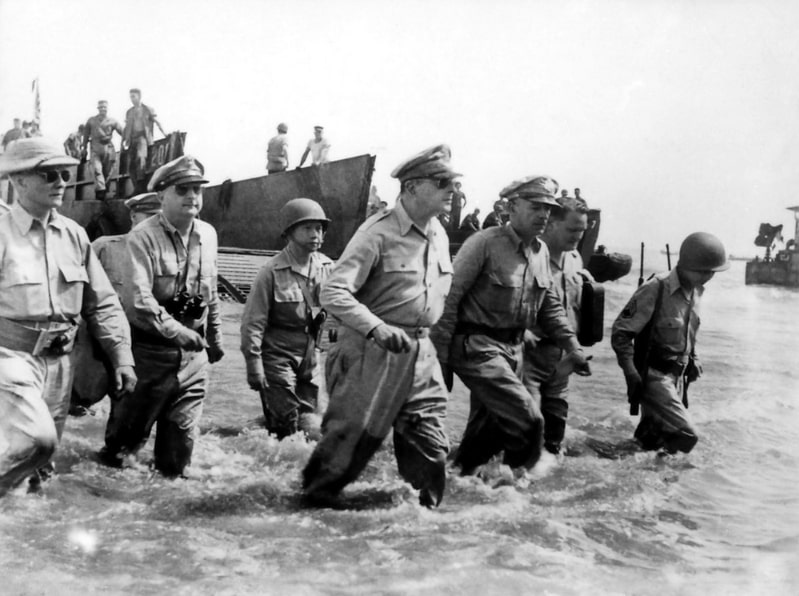Introduction: In this article – the second of two – Katie Rebecca Garner gives tips for researching your WWII veteran ancestors. Katie specializes in U.S. research for family history, enjoys writing and researching, and is developing curricula for teaching children genealogy.
In the previous article in this series, we learned what we could discover about our ancestors in their WWII records. In this article, we will learn what kinds of documents to search for to find your WWII ancestor’s story.

Record Types and Record Loss
As mentioned in the previous article, discharge papers are an excellent place to start researching a WWII veteran ancestor. This form is given to someone upon leaving the military, so it is only available for an ancestor who returned from WWII alive. For an ancestor that died in WWII, the record to obtain is the Individual Deceased Personnel Files.
The first place to check for discharge papers is to see if it’s in the veteran’s or any immediate family’s possession. The next place to check is the National Personnel Records Center (NPRC).
Note that many records housed at the NPRC were lost to a fire in the 1970s. Many of the records not destroyed by fire were destroyed by the water that put out the fire. When a request is made to the NPRC, they will either send what records they have or a statement indicating the records were destroyed.
You could also try getting the discharge papers from the federal or state Department of Veteran Affairs (VA). If the veteran applied for benefits, they would have had to submit a copy of their discharge papers. The drawback is that some states have privacy restrictions on who is allowed access to the records. In this case, the children of the veteran are usually given access.
Finally, check the county register of deeds. After WWII, veterans were encouraged to register their discharge papers with the local register of deeds – the discharge papers of the veterans that did that are housed with their county.
If your ancestor died in WWII, you would want to obtain the Individual Deceased Personnel File instead of discharge papers. For this, you must write to the unit your ancestor served in. The information in these files varies from unit to unit; some contain minimal information, while some contain detailed reports of the action the ancestor died in. The tricky part of this can be finding the current address of your ancestor’s unit because some of the units often change addresses.
Furthermore, you can search for obituaries and newspaper articles about the soldier’s death. The obituary or newspaper article may state his unit and other details about his service. Some communities’ newspapers published lists of soldiers who died in the war. Be sure to check out GenealogyBank’s Historical Newspaper Archives for this.
Whether your veteran ancestor died in WWII or long after, burial records are a good source of information. For those who died in war and are buried overseas, look for information in the American Battle Monuments Commission. Also, check out the Federal VA gravesite locator and Find-A-Grave.
Photos of your ancestor in uniform, letters they wrote, and family lore can also lend helpful clues to your research. Photos might portray awards or decorations your ancestor received, which you can then look up to gain additional information. The return address of letters they wrote home would include unit information. Family lore should always be treated as a clue rather than as a fact.
The following is a list of databases for WWII military research:
- Morning reports, accessed through NARA
- FamilySearch wiki
- Order of Battle, a reference material on WWII battles the U.S. was involved in. There are two volumes, one for the European Theater of Operations and one for the Pacific Theater of Operations. Both are available digitally:
- Pacific Theater
- European Theater
- American Battle Monuments Commission for U.S. soldiers who are buried overseas
- National Personnel Records Center
- A state’s military museum may have information about soldiers from that state
- Refer to this document once you get your ancestor’s discharge papers to understand the terms and acronyms
Whatever your WWII veteran ancestor’s story is, it deserves to be remembered.
Explore over 330 years of newspapers and historical records in GenealogyBank. Discover your family story! Start a 7-Day Free Trial
Related Article:

I’d like to clarify something about accessing the Individual Deceased Personnel File (IDPF). The access described in the article is incorrect. They have never been held by the units. IDPFs have been moved around quite a lot and access given and then taken away for almost the last 8-9 years. However, as of 29 August 2023, this is the current way to access these files.
To access IDPFs people can request surnames A-L from the National Personnel Records Center (NPRC) in St. Louis. You can send in Form 180 to request or hire a researcher.
Surnames M-Z require a FOIA request via email to Army Human Command at Ft. Knox. The email is: ‘usarmy.knox.hrc.mbx.foia@army.mil’
Also, if NPRC sends you a letter that all the files burned, this isn’t quite accurate. There are plenty of records to access to reconstruct the service BUT, NPRC won’t do that work for you. You have to go there or hire a researcher. For every client I’ve worked with I’ve been able to reconstruct the service.
If you’d like to learn more about WWI and WWII research, you can visit the WWII Research & Writing Center https://wwiirwc.com to access articles, videos, books, and classes. I have a 2-part strategy to research any veteran even if the records burned.
Thanks for sending in this information, Jennifer.
You’re welcome.